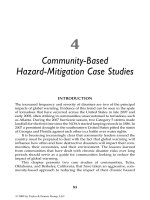Slide Financial Management - Chapter 21 pot
Bạn đang xem bản rút gọn của tài liệu. Xem và tải ngay bản đầy đủ của tài liệu tại đây (109.25 KB, 18 trang )
21-1
CHAPTER 21
Mergers and Divestitures
Types of mergers
Merger analysis
Role of investment bankers
Corporate alliances
LBOs, divestitures, and holding
companies
21-2
Why do mergers occur?
Synergy: Value of the whole exceeds sum
of the parts. Could arise from:
Operating economies
Financial economies
Differential management efficiency
Increased market power
Taxes (use accumulated losses)
Break-up value: Assets would be more
valuable if sold to some other company.
21-3
What are some questionable
reasons for mergers?
Diversification
Purchase of assets at below
replacement cost
Get bigger using debt-financed
mergers to help fight off takeovers
21-4
What is the difference between a
“friendly”
and a “hostile”
takeover?
Friendly merger:
The merger is supported by the
managements of both firms.
Hostile merger:
Target firm’s management resists the merger.
Acquirer must go directly to the target firm’s
stockholders try to get 51% to tender their
shares.
Often, mergers that start out hostile end up
as friendly when offer price is raised.
21-5
Reasons why alliances can make
more sense than acquisitions
Access to new markets and
technologies
Multiple parties share risks and
expenses
Rivals can often work together
harmoniously
Antitrust laws can shelter cooperative
R&D activities
21-6
Merger analysis:
Post-merger cash flow statements
2003
2004
2005
2006
Net sales
$60.0
$90.0
$112.5
$127.5
-
Cost of goods sold
36.0
54.0
67.5
76.5
-
Selling/admin. exp.
4.5
6.0
7.5
9.0
-
Interest expense
3.0
4.5
4.5
6.0
EBT
16.5
25.5
33.0
36.0
-Taxes
6.6
10.2
13.2
14.4
Net Income
9.9
15.3
19.8
21.6
Retentions
0.0
7.5
6.0
4.5
Cash flow
9.9
7.8
13.8
17.1
21-7
What is the appropriate discount rate
to apply to the target’s cash flows?
Estimated cash flows are residuals which
belong to acquirer’s shareholders.
They are riskier than the typical capital
budgeting cash flows. Because fixed
interest charges are deducted, this
increases the volatility of the residual cash
flows.
Because the cash flows are risky equity
flows, they should be discounted using the
cost of equity rather than the WACC.
21-8
Discounting the target’s cash flows
The cash flows reflect the target’s
business risk, not the acquiring
company’s.
However, the merger will affect the
target’s leverage and tax rate, hence
its financial risk.
21-9
Calculating terminal value
Find the appropriate discount rate
k
S(Target)
= k
RF
+ (k
M
–k
RF
)β
Target
= 9% + (4%)(1.3) = 14.2%
Determine terminal value
TV
2006
= CF
2006
(1 + g) / (k
S
–g)
= $17.1 (1.06) / (0.142 –
0.06)
=$221.0 million
21-10
Net cash flow stream
2003
2004
2005
2006
Annual cash flow
$9.9
$7.8
$13.8 $ 17.1
Terminal value
221.0
Net cash flow
$9.9
$7.8
$13.8 $238.1
Value of target firm
Enter CFs in calculator CFLO register, and
enter I/YR = 14.2%.
Solve for NPV = $163.9
million
21-11
Would another acquiring
company obtain the same value?
No. The input estimates would be
different, and different synergies would
lead to different cash flow forecasts.
Also, a different financing mix or tax rate
would change the discount rate.
21-12
The target firm has 10 million shares
outstanding at a price of $9.00 per share.
What should the offering price be?
The acquirer estimates the maximum price
they would be willing to pay by dividing the
target’s value by its number of shares:
Max price
= Target’s value / # of shares
= $163.9 million / 10 million
= $16.39
Offering range is between $9 and $16.39 per
share.
21-13
Making the offer
The offer could range from $9 to
$16.39 per share.
At $9 all the merger benefits would
go to the acquirer’s shareholders.
At $16.39, all value added would go
to the target’s shareholders.
Acquiring and target firms must
decide how much wealth they are
willing to forego.
21-14
Shareholder wealth in a merger
Shareholders’
Wealth
Acquirer Target
Bargaining
Range
Price Paid
for Target
$9.00 $16.39
0 5 10 15 20
21-15
Shareholder wealth
Nothing magic about crossover price from
the graph.
Actual price would be determined by
bargaining. Higher if target is in better
bargaining position, lower if acquirer is.
If target is good fit for many acquirers,
other firms will come in, price will be bid
up. If not, could be close to $9.
21-16
Shareholder wealth
Acquirer might want to make high
“preemptive” bid to ward off other
bidders, or low bid and then plan to go up.
It all depends upon their strategy.
Do target’s managers have 51% of stock
and want to remain in control?
What kind of personal deal will target’s
managers get?
21-17
Do mergers really create value?
The evidence strongly suggests:
Acquisitions do create value as a result
of economies of scale, other synergies,
and/or better management.
Shareholders of target firms reap most
of the benefits, because of competitive
bids.
21-18
Functions of Investment Bankers
in Mergers
Arranging mergers
Assisting in defensive tactics
Establishing a fair value
Financing mergers
Risk arbitrage









